Christmas is almost here and seafood will undoubtedly be on the menu in Spain, so if you fancy preparing something a little different “ arroz caldoso de Bogavante” could be a special alternative.
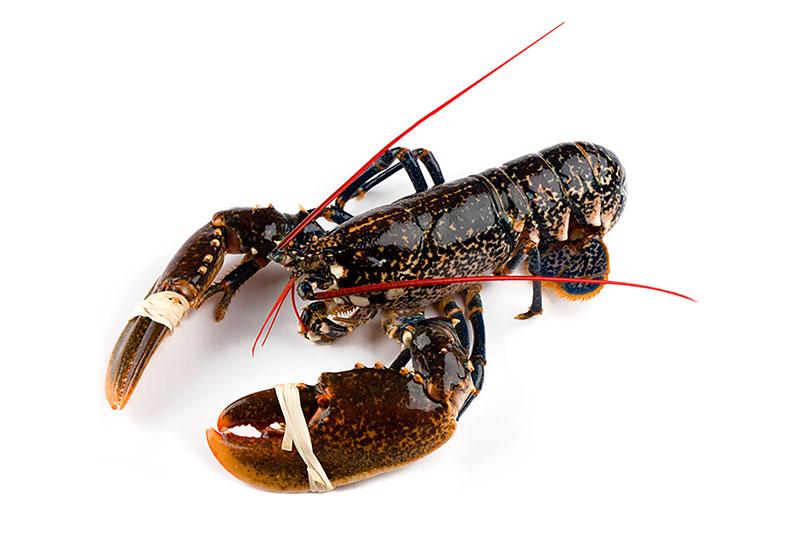 To be honest it is quite confusing to give a decent translation for this dish, yes, it is Lobster Rice but it is not dry like paella is, it is cooked so that the lobster and the rice are left with a reasonable amount of broth or seafood stock making it almost soupy without being a soup! It is in essence a rice stew: a combination of solid food ingredients (lobster and rice) that have been cooked in liquid (seafood fumée) and served in the resultant gravy - according to the dictionary! However, one thing I can assure you is that this is one special stew!
To be honest it is quite confusing to give a decent translation for this dish, yes, it is Lobster Rice but it is not dry like paella is, it is cooked so that the lobster and the rice are left with a reasonable amount of broth or seafood stock making it almost soupy without being a soup! It is in essence a rice stew: a combination of solid food ingredients (lobster and rice) that have been cooked in liquid (seafood fumée) and served in the resultant gravy - according to the dictionary! However, one thing I can assure you is that this is one special stew!
I’ve cooked many rice dishes over the years and untold “calderetas” (stews) so the techniques are straightforward, it has always been the fact that I knew I would have to kill the lobster while it is still alive that always held me back. However, I figured it was time to tackle this dish once and for all.
When making a Lobster Stew you need to chop up the lobster while it is still alive so the meat doesn’t toughen. So be prepared for this! In reality, it is a very easy dish to make but the real secret is in the seafood stock, which must be prepared beforehand. It is the same stock you would use for seafood paella, so that was one of my specialities. In fact, the recipe is exactly the same for a Lobster paella only we would use less stock and let it dry out.
So, off I went to stock up on ingredients and there are quite a few, even though it is a rather simple recipe, the one I made was for 4 hungry adults, so adjusted the ingredients accordingly. (five could eat easily from this recipe, though). I might add that if you decide to go ahead and try the dish you could buy the ingredients frozen ahead of time as prices will soar the closer it gets to Christmas. The results will still be very good, although live lobster is always much better. You decide...
For the Seafood Fumée (stock) you will need the following:
400g of small raw unpeeled prawns/shrimps (Gambas arroceras or Gamba blanca)
500g of raw unpeeled “langoustine/scampi/Norway lobster/Dublin Bay prawn” (whatever you want to call it! In Spanish: Cigalas)
400g of Mantis Shrimps that look like aliens but are just for flavour! (Galeras)
4 large Scarlet (Cardinal) prawns - (Carabineros in Spain) – these are quite pricey so you can omit them if you want, but if you want a no-holds-barred stock, I highly recommend them, they are intense in flavour.
600g of white fish bones with head, such as hake or monkfish which are very flavourful.
2 tbsp Fresh chopped parsley
1 large onion chopped into quarters
2 peeled cloves of garlic (whole)
100ml Extra Virgin Olive Oil – Picual variety
50ml Brandy ó Cognac (sherry will do as well)
50ml White wine (preferably Albariño)
1 tbsp Paprika
2,5 litres of water approx.
Salt
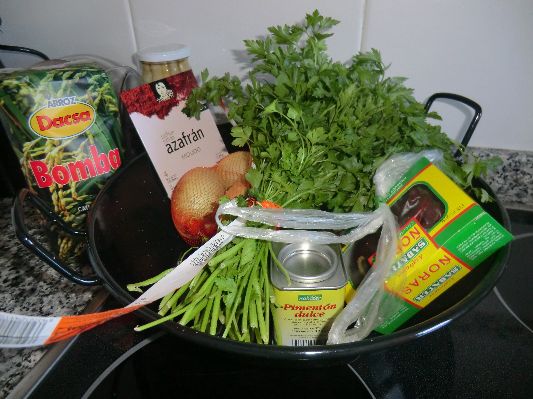
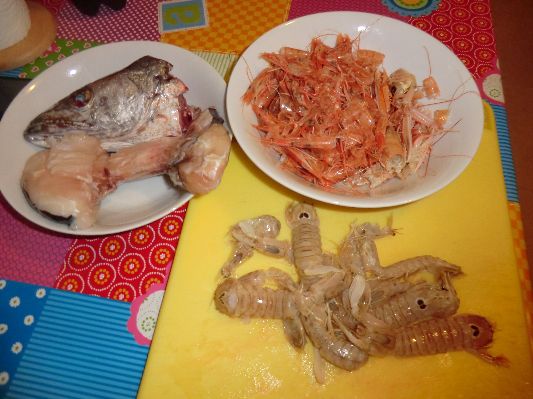
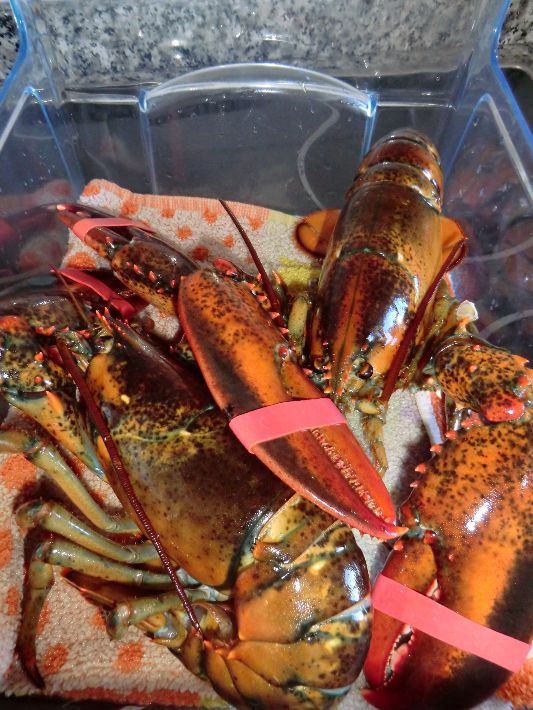
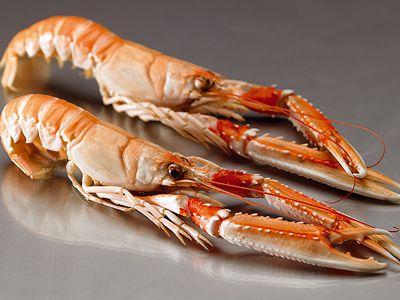
Scampi / Cigalas
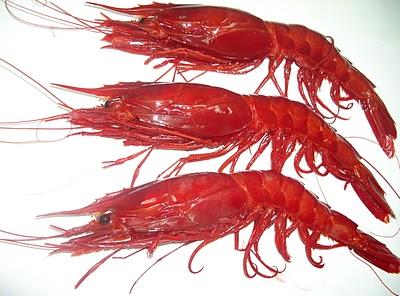
Carabineros / Scarlet or Cardinal Prawns
The first thing we do is peel the prawns, langoustines and carabineros, putting the meat from the tail to one side and reserving the heads and the shells. The meat we will add with the lobster, later. It is a waste to use it in the stock as the real flavour comes from the heads and the shells. I don’t peel the mantis prawns because it’s such an ordeal and they don’t tend to have much meat in them.
Then we place all the heads, shells and mantis prawns in a large deep saucepan on high heat, as this is where we will make the stock. Pour in the olive oil, I recommend using a Picual variety as we are heating to high temperatures at first and this will withstand the heat better. When I made this recipe I used “Oro Bailen” which is available in most supermarkets and a very good olive oil for the price.
.jpeg)
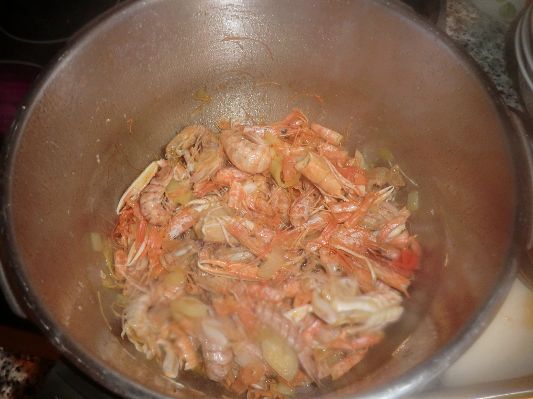
.JPG)
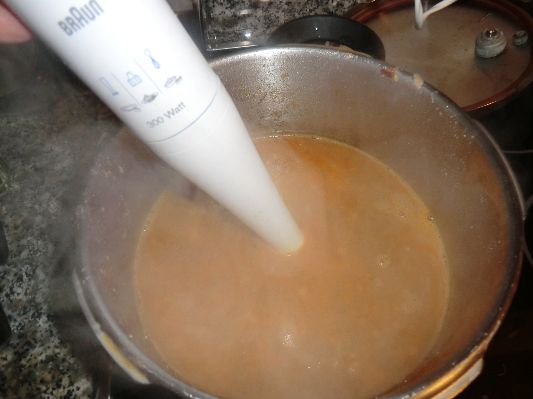
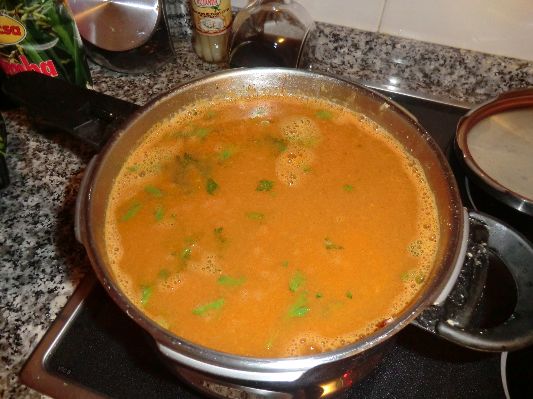
We cook the shells and heads for about five minutes until they have all changed colour and start to brown a very little, you will experience a fantastic smell as you are doing this, of sweet seafood. Then we add the cognac or brandy, and flambé the shells, to burn off the alcohol. If you use Brandy you can’t flambé it, so don’t worry the alcohol will evaporate as the cooking proceeds.
Add the wine and stir for about 2 minutes then add the paprika, stir it around and add half a litre of water immediately so the paprika doesn’t burn. Let it simmer for about 10 minutes. Next, we need to get a hand blender and blend in all the heads and shells with the stock. Do this in short actions, we don’t want all the shells to disintegrate into tiny pieces we just want to break them all up into small pieces so that they release every ounce of their flavour, we’ll pass it through a sieve later. Now drop in the quartered onion, the cloves of garlic and the fresh parsley, add the fish head and bones and add the rest of the water.
We want to end up with 1,5 litres of concentrated stock at the end of all this so, add a litre first and that will give you a guide as to the minimum amount we will need once we’ve reduced the stock. Let the stock simmer for a minimum of 1 hour until all the fish bones have separated and any meat that was there has fallen off, skim the foam off the top as needed.
Now we pass all the stock through a sieve to remove the bones and the broken shells. I suggest you pass it through the sieve twice to make sure you remove everything. Now the last step is to salt for taste and slowly reduce the stock to the required amount so it is lovely and concentrated. As I mentioned, we want a minimum of 1,5 litres for this recipe which will be used for 500g of rice, It is always best to leave a little in reserve just in case.
Once the stock is ready put it to one side. You can make the stock the day before if you want, it will keep in the fridge for a couple of days.
Now the next step! These are the ingredients you will need for Lobster rice, as I mentioned it serves 4 hungry adults!
2 medium-sized lobsters ( approx 500-600 g each)
The peeled seafood from earlier
500g Round Valencian Rice ( If possible Bomba), the same rice you would use for a paella.
4 sundried Spanish Ñoras (dried capsicums)
3 mature medium sized plum tomatoes
1 medium-sized red onion
2 cloves of garlic
1 tsp. paprika
0,2g ground saffron
50ml Brandy
50ml Extra Virgin Olive Oil
Fresh parsley
Salt
Now we are at the moment of truth. Time to kill! But just before that, we need to get everything ready. Capsicums always come dried, well they do here in Spain at least, so they need to be soaked in water overnight so they can soften.
Once softened, we remove the pulp from the capsicums with a teaspoon and place it in a bowl, discarding the tough outer skin. We scald the plum tomatoes in boiling water and then immediately place them under cold water to easily peel off the skin and then finely dice it. Chop the onion and garlic cloves up finely too. Mix it all these ingredients together; capsicum pulp, onion, tomatoes and garlic, now we are ready to move on.
Make sure the stock is hot and keep it hot, as we must add it hot to the pan. For this you will need a deep wide pan, in Spain we use a pan similar to a wok only that it has a larger base.
The lobsters' time is now up, say a prayer, give them a blessing and ask them for forgiveness, as they are about to serve you very well indeed! A lobster will stay alive for just over a day in the fridge if you keep it moist, so a good trick is to get two kitchen cloths, soak them in water and a place one on the base of the vegetable drawer inside the fridge, lay the lobster on top of the cloth and place another wet cloth over them. When you buy them make sure they are healthy, a good telltale sign is asking for them to be held up in front of you once they are taken out of the tank, they should hold their claws up high as if surrendering, if their claws are sagging down towards their body, they are weak and I would reject them.
There are many ways to chop up a lobster but I quickly learnt my first mistake, not pulling the claws off first. If you don’t, it is much harder to take them off once you’ve cut it in half. So hold the lobster firmly by the head and twist the claw firmly at the base where it is joined to the body, it should just pop off. Remove both of them, hit them with a rolling pin to slightly break the shell (don’t bash them!) in each part of the arm and claw and then put them to one side, you can take the elastic bands off now. Next, we need to separate the tail from the head and cut it in half lengthways, you will need a large sharp knife for this. Finally cut the head in half lengthways and we are done. The last thing you will need to do is remove the stomach, it is right at the tip of the head and is a small sack, sometimes with sand in it. Take it out and throw it away. You needn’t remove anything else, the green innards that look like brains, aren’t in fact brains and will add to the flavour, but if you find that a bit sickly, wash it out, it’s not the end of the world if you don’t include it. Heat the pan and add the olive oil (Picual) and then place the lobster pieces shell down in the pan and fry them until the shell goes pink turn them over and seal the meat briefly and let it release the juices, fry for a few minutes, we just want to flavour the oil. Remove the lobster and put it to one side.
Then we add to the pan the tomato-onion-garlic-capsicum mix and stir fry it in the oil for about 5/6 minutes until it is nicely cooked. Add the brandy and stir, let it simmer for a minute or so and then add the paprika, stir it in and almost immediately add all the rice. Stir in the rice so it soaks up all the ingredients in the pan and keep stirring it for a couple of minutes then we add the stock. Add 1.5 litres of stock, stir it in and put the lobster and the peeled seafood which we reserved earlier, back in. Add the saffron and some chopped parsley to the pan, slowly stir it in and taste for salt. Add if necessary. Now we just wait for approximately 20 minutes until the rice is cooked. The pan should not run out of stock, if you see the stock going below the rice level, add a little more, but make sure it is always very hot. Remove from the heat and let it stand for 5 minutes. It is now ready to serve! It is truly a fantastically special dish! I hope you enjoy it!
.jpg)
.jpg)